Here are the bike-related links from around the world that caught our eyes this week:
Traffic overloads: Here’s the problem with thinking of congested city streets as a backlogged garden hose that needs widening: “cities aren’t the hoses, they’re the gardens.”
Footballer cyclist: Former Pro Bowl tight end Kellen Winslow Jr. wants to be the first NFL player to become a professional biker.
Stop-sign stings: A blogger for SFGate.com has published a brief but thorough explanation of why it is dumb to enforce full stop sign stops by people biking. “If we can only punish a tiny fraction of traffic violations … the crucial question … is which tiny fraction of violations we should punish.”
Canadian scandal: Prime Minister Stephen Harper’s campaign bus got caught parking in a bike lane.
Sounds familiar: “Immigrants to Singapore consume far more niceness than they would like to, and at high prices,” writes Tyler Cowen, finding a good way to describe the biggest problem of a thriving city.
Dutch car love: Dutch bike infrastructure doesn’t reflect a lack of enthusiasm for cars, explains David Hembrow. Just the opposite — it allows the Dutch to bike comfortably in a car-loving country.
Advertisement
Gas tax: Michigan’s Republican governor is arguing that if he got re-elected while pushing for higher gas taxes, other politicians can too.
Acceptable jaywalking: D.C. engineer Bill Schultheiss says he calls the refusal to wait for this pedestrian signal before crossing the street the “Idaho walk.”
This scene repeats itself everywhere #RewardingTheCarTrip #IdahoWalk #IdahoStop #LOS_A for who? pic.twitter.com/PUahTKFUBx
— Bill Schultheiss (@schlthss) August 7, 2015
Bike capital: Carlton Reid follows up on his piece about Portland biking with a story about how the bikingest city in the United States, Davis, Calif., rose and (for a while, at least) fell from grace.
Pedestrian rage? As Seattle’s sidewalks crowd, some say they’re seeing it.
Door ramps: The brilliant bike-friendly designers at Toyota have come up with an innovative solution to dooring collisions, reports Clickhole.
Stoplight history: The traffic signal turned 101 last week. The Telegraph has an array of stoplight trivia.
Armstrong’s doctors: Did they know about the disgraced bike champion’s doping back in 1996? Federal prosecutors are trying to find out.
Operating costs: “You don’t not build a road because you’re going to have to maintain it,” says a congressman from Louisiana, inadvertently explaining the reason for the U.S. infrastructure crisis.
And in your video of the week, a GoPro in Seattle captures a man seemingly operating his cell phone while hitting a bike … and a 911 call captures the same man confessing, later that day, to hit-and-run.
— If you come across a noteworthy story, send it in via email, Tweet @bikeportland, or whatever else and we’ll consider adding it to next Monday’s roundup.

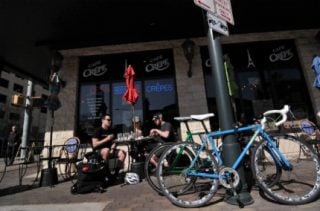
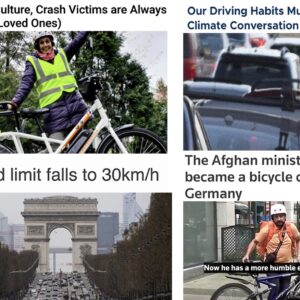
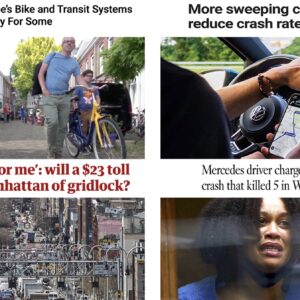
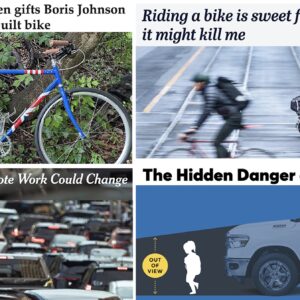
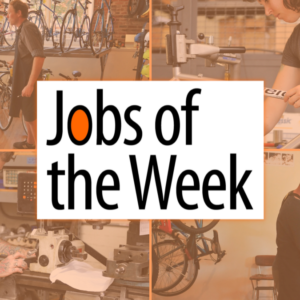
Davis California really has fallen far from grace. In the springtime the city allows residents to pile their yard debris in the neighborhood street bike lanes for pickup by city crews. It often is there for a couple of weeks each year. Riding the Davis Double Century one year with an early start in the morning I almost plowed into some of the piles in the dark! NOT bike friendly!
Pretty sure they’re going to be switching over to bins in the next few years. I remember hearing something about how they’d have to eventually because of some code/rule/law somewhere higher up.
So we have video evidence, and a 911 call of a hit and run, but charges have not been filed? The apologist attitude of that piece is disturbing. The even mention a “online debate, as to who is at fault”. Ridiculous.
I noted the news piece also didn’t play the video at full speed, twice, during the report, making it look like a slow speed collision where the bicycle operator had plenty of time to avoid the collision. Toward the very end of the piece, they finally show it at full speed and you can see that he, the cyclist, was traveling at a good speed and wasn’t able to come to a full stop as the SUV driver turned across his path.
It looked like the rear of the SUV was knocked sideways. I don’t know if that’s just the camera angle or a fishtail from the freaked out hit-and-run driver, but it makes it look like quite a hit from a not very big guy on the bike. This actually seemed like a shockingly even-handed report — they didn’t even call it an “accident” (stockholm? never been there.) They do say “biker”, “cyclist”, and “driver” a lot, plus the parting tip “if you hit someone, it’s probably fine if you just don’t run”. I see what you mean about “the internet said it was the biker’s fault”, but they did at least counter with the correct answer (provided by the police, which also seemed slightly amazing.)
The problem, is that the report would not have been even-handed if the roles were reversed. If a cyclist had ran down a pedestrian in a crosswalk, pedaled away, and then had his mommy call 911 for him to report the crime a few hours later, the news coverage would have been totally different.
Seriously, in that situation the cyclist would have been raked over the coals (“Hell on 2 Wheels”) and politicians would be calling for new legislation and increased enforcement to curb the dangers cyclists pose. Ugh
If it’s anything like the hit and run that my neighbor was killed by, the fact that he left the scene will be irrelevant if it’s his first offence.
I assume the Toyota door ramp is a joke?
Yes. Clickhole is The Onion News Network’s response to Buzzfeed.
No. It’s real news.
Seattle: where pizza is more important than safety for people on bikes.
Similar to Portland, except instead of pizza, parking is more important thank people here.
I lived in Davis from 1980-2000, so I saw the peak of its Bike Capital of the World glory and its fall from grace up close. In fact, in the dark years of the ’90s my family was known as “The Bike Family” because we, and a small cabal of us, refused to stop riding. The Guardian article is rife with errors. Here’s a partial list, in order:
1. In 1980 the bike modal share was far higher than 30%. It was common to look down a long, straight street (the only kind) and see thousands of bikes and no cars. I’m not sure where that number comes from, but it’s BS. Active bike parking, not overnight storage, was overwhelmed to the point of bikes perpendicular to the street four deep for blocks at a time while the then-small-number of car parking lots stood 95% empty.
2. Students in residence halls were allowed to purchase “C” campus parking permits. That changed as the city and university entered the dark era, at which time demand for car parking increased so dramatically that they pushed the student cars aside.
3. Lecture halls are quite close together on the UC Davis campus. They are so close that many students, after riding to campus, simply left their bikes parked rather than engage in the search for parking near their next lecture. And ten minutes (twenty at noon) is hardly tight timing; an average person can walk over a kilometer in that time.
4. David Takemoto-Weerts didn’t see much of the decline of the bike in Davis. It was already mostly done by the time he got there. He was actually a factor in making it worse, as was Dave Kemp. Their incessant push for segregation created some real dangers and dramatically slowed cyclists down to the point that it was faster to drive.
5.Opinions are not necessarily errors, but the people calling for more “wow” infrastructure should acknowledge that we had one bike path and a handful of bike lanes back when literally everyone got around on bikes. It wasn’t segregation that made Davis the bike capital, it was vigorous traffic law enforcement by both local police departments (city of Davis and UC Davis), as well as an educated community seeing the insanity of oil dependence. Driving’s a hassle when failing to fully stop behind the limit line gets you a ticket much of the time, speed limits are enforced and you can’t park illegally.
6. Long distance motorized commuter Earl Bossard is incorrect when he blames the city’s alleged focus on cars for the loss of bikes. In fact, the city has added incredible amounts of segregated bike infrastructure over the past thirty years. The problem is that during this same time both the city and the campus gave up on traffic law enforcement, which dramatically changed the cycling experience. You can’t segregate the stores, so people who would previously have ridden took to driving when they perceived the motorists being dangerous. Contrary to the popular myth, they built the segregated infrastructure and that coincided with a dramatic decline in bike use. Be careful what you wish for, PDX.
I’ll just add that during the golden years, 1970-85, about 5% of the residents either rode the annual Davis Double Century (simply known as the DC) or volunteered at the rest stops. Most volunteers rode their bikes to where they helped out and it was considered quite normal for people to ride hundreds of miles per week simply for the pleasure of the activity. There was no Balkanization of cycling into recreational and utility; we all did all of it,mostly.
When someone arrived somewhere by car, the first thing they were asked is whether or not they were okay (everyone assumed they were ill or injured because driving was so abnormal). The day I met my faculty advisor, he was on the phone chewing out a new faculty member for not having a bike yet. “How can we go out to lunch if you don’t have a bike? No you can’t go there by car. That’s just stupid! It takes too long to drive there and park.”
Number 4 is in Portland’s future…
In many ways, Portland, Oregon differs dramatically from Davis, California. As it does from Amsterdam, Copenhagen, etc. Portland isn’t likely to be able to replicate the cycling environments of those cities idolized for their particular culture of biking.
There are fundamental realities to face, among which, is the fact that for many types of ordinary non-cyclist type people, Portland and other cities in the metro area, aren’t great for biking. In its relative history, no city in our area has ever had the kind of excellent conditions for biking that Davis, Cali had, dating from the early 60’s to today, described in the Guardian story. And despite having those great conditions for biking, many Davis residents that had been biking, may have gradually decided biking in their city wasn’t quite what it was cracked up to be. Maybe the reason was partly a generational thing.
Not sure of all that cities here in the Tualitan and Willamette Valley need to support an interest in practical biking, but at least a basic, somewhat separated number biking routes are likely part of the answer. I believe there are people willing to put up with some cold, wet, and heat, that would ride some if they had a reasonably low stress place to ride. For many people that may otherwise ride, out on heavily congested streets in the midst of many motor vehicles, isn’t going to cut it.
Do for Oregon and Oregonians, what people here need. Help people here conceive, design and build infrastructure for biking that will enable biking to be a good experience despite the weather and motor vehicle congested roads, and it’s possible more and more people will take advantage of the opportunity available to enjoy a blissful ride.
Mode share data comes from the ACS (previously the Census long form). It refers exclusively to commuting, and does not allow for multi-modal data. So if a resident of Davis did 99% of their travel by bike, but drove to Sacramento for a job 3 times a week, theyd be considered a single occupancy vehicle driver.
So in the glory days the roads were dominated by bikes, then cars took them over. Bike dominance on the roads was fragile, hard to sustain, and when cars got a foothold bikes couldn’t regain the space they once had.
Was there some important string of auto-oriented development leading to more people that really wanted to drive, who then pushed bikes off the road? Did more bike lanes effectively give more space to cars, making driving more attractive and biking more complicated (being in the door zone and having cars passing you compared to just rolling down the middle of the street)? Or do you think culture and enforcement were the big, important issues?
This needs to be said to PPB. All I ever hear from them is excuses about not being able to write tickets for speeding 1-11mph over. Granted, they don’t have the staff for adequate enforcement because the budget is blown on pensions, but their problem is at least partly in culture and leadership, including city hall and even state law and the courts share the blame. How often do you see a police cruiser travelling at the posted speed?
“…they built the segregated infrastructure and that coincided with a dramatic decline in bike use. Be careful what you wish for, PDX.”
Be very, very, very careful…
Segregation should not be a goal unto itself. It WILL slow down bicyclists, crowd them into MORE dangerous positions/situations, and make bicycling less attractive to all but the “Timid and Fearful” unless done very, very, carefully—and not “on the cheap”.
Safety should be the goal—real safety, not “a feeling of safety”. A “feeling of safety” is what you get right before your freedom disappears—and it probably doesn’t correspond to any kind of real safety (see the TSA).
I think the truth is a little more nuanced. “A feeling of safety” has value if it gets more people on bikes. The health benefits of active transportation far, far outweigh the risks (even in today’s Portland, which is more dangerous than it should be).
How is Portland so dangerous? The numbers don’t paint that picture, in fact our injury and fatality rates for bicycle riders are not that far off from Copenhagen’s.
Yes, they have a higher ridership percentage, but they’re about 100k less people, and their average trips per person (around 1-1.5 miles) is less than half of the typical Portland commuter (3-5 miles).
They’ve done a great job pushing the image of being the gold standard for bicycle use, but I suspect many cities that you wouldn’t even think of rival them in “safety” numbers even without the infrastructure.
I’ve actually started trying to compile some of this information already, though you’d be surprised how hard it is to find the actual numbers for some of those bike capitals (hummmm?!?).
We as a city average nearly 2 fatalities (multiple years with 0 in the in last decade) a year and 22 injuries with cars. (you can check out the graphs on PDOT’s Vision Zero charts).
And if you really want more people riding, quit saying that riding a bicycle isn’t safe. First of all riding a bicycle is safe. And second, blaming infrastructure shifts the responsibility from the bad drivers actions, bad road user education, and poor enforcement and is essentially forgiving all of them. Additionally it is victim blaming a pile of concrete or yet another distracting sign which can’t fight back and isn’t really the problem.
Been thinking more and more that we need a real push by BTA or METRO or some other organization that sponsors or induces an everybody bikes week. Beyond the bike to work challenge, a real blitz everywhere around the city and on all mediums to say, hey, it is really safe to bike in Portland, and week of XX-XX-XXXX we are all biking the city. Everyone will be out there bicycling, as if it’s Sunday Parkways, so no excuses, you will have safety in numbers. It’s really safe and really fun and if you’ve been nervous to do it, here is the week to start and here is someone in your neighborhood who bikes who you can talk to, etc, etc.
Something like that. Probably have to fine tune it.
Well, maybe I’ll think on this more.
Don’t confuse cycling mileage per capita with cycling mileage per cyclist. In Copenhagen, 1-1.5 miles/day is per capita; with 1/3 of the population cycling that makes the average amount per cyclist about three times as much. Meanwhile in Portland you only have about 1/16 of the population cycling, so that’s only about 1/4 mile per capita.
All this important when trying to compare crash stats, as total miles-cycled is one of the more reliable estimators of cycle crash numbers when considering relative risk. However invariably, despite the media/public concern about cycle safety, the actual cycle risk rates (whether you’re in Copenhagen, Portland, New York, wherever) are all still very small numbers.
“…And if you really want more people riding, quit saying that riding a bicycle isn’t safe. First of all riding a bicycle is safe. And second, blaming infrastructure shifts the responsibility from the bad drivers actions, bad road user education, and poor enforcement and is essentially forgiving all of them. …” gutterbunnybikes
Biking in Davis, California, reportedly has been safe for decades, and still…though it seems not to be known exactly why, mode share of biking has dramatically dropped.
On the strength of statistics, telling people that biking amongst motor vehicles is safe, does no good, because people riding in that situation, that are adverse to possibilities however unsupported by statistics, that they could be knocked down or run over by the person driving one of those vehicles, seem to need no more than that fundamental awareness to have them decide not to ride.
Cities and neighborhoods should have street and infrastructure that’s functional and appealing for active transportation, irrespective of whether a particular active mode share stays constant over years or perhaps decades. That’s because walking and biking are the most basic modes of transportation. A lack of this type infrastructure, virtually precludes by many people, the possible choice of walking or biking over travel by motor vehicle.
“…which is more dangerous than it should be.”
Isn’t that just about everywhere? 😉
I think the “feeling of safety” that people have in cars also plays a role in downplaying the actual safety of riding a bicycle among them. Cars are really only “safe” because in years past they were significantly less so, and both an insurance industry and marketing professionals saw tremendous value in convincing people they are. Fast forward to the uptick we see in pedestrian fatalities today, and I suspect the majority of the population believes (maybe subconsciously) that roadways are inherently dangerous, unless you’re wrapped in sheet metal and air bags (with a seat belt on, of course).
And that’s the problem, no ever argues that driving/riding in a car isn’t safe, even though it is hands down the least safe transportation option available – the contest isn’t even close.
This is a no brainer, everyone knows riding in cars isn’t safe. Entire motor companies use their safety rating as their main selling point. And somehow; despite all the facts and figures, peoples perceptions is that driving is safe even though in a backhanded way the entire automobile industry admits it isn’t all the time. They not only think it’s safe, they think it’s safest.
But none of the automobile manufactures, or their press, or their advocates will ever say that driving isn’t safe and they can do so honestly- despite all the daily reminders in the news, traffic reports – even when they witness it themselves as either a participant or witness, because 99%+ of the time, it’s not the cars that are the cause of the collisions – it’s the drivers.
And as the incident today with some guy driving on the sidewalk of the Broadway Bridge so clearly points out, infrastructure only works when drivers want it to work.
http://bicycleuniverse.info/transpo/almanac-safety.html
“So cyclists are either 3.4x or 11.5x as likely to die as motorists, per passenger mile. Neither conclusion is very happy.”
I’d ignore the bit where he tries to discount the cases where a cyclist was riding dangerously since he doesn’t subtract out the cases where the driver of a car does the same.
http://www-nrd.nhtsa.dot.gov/Pubs/812102.pdf
35% of drivers involved in a single vehicle fatal crash in 2013 had a BAC of at least 0.08, 47% at night.
Maybe driving/riding in a car isn’t the worst? Though if more people chose a lifestyle that allowed them to bike a small number of miles instead of drive a great number of miles that would reduce transportation related fatalities.
fender benders are common and generally do not result in significant injuries. however, bike collisions are also common and often cause significant injuries. i also strongly suspect that the rate of significant injury among cyclists in PDX is much higher than in CPH.
“…no ever argues that driving/riding in a car isn’t safe, even though it is hands down the least safe transportation option available – the contest isn’t even close.
This is a no brainer, everyone knows riding in cars isn’t safe. …” gutterbunnybikes
Oh, c’mon now…people in fact know very well that in many road use situations…such as riding around the city at speeds up to say, 30mph (a rather high speed for bikes), travel in cars is very safe. Which seems to be one of the big reasons many people drive rather than ride a bike in traffic, surrounded by a lot of motor vehicles in operation.
Infrastructure for safe, comfortable and enjoyable, practical biking…should be more commonly available though. That’s something that cities with growing populations should be embracing, even if providing the infrastructure isn’t a guarantee that people will take to riding it in consistently high mode share percentages.
I’ve heard from past discussions on other blogs from people that live in countries having about separated bike infrastructure, i.e. cycle tracks, etc, that the availability of that infrastructure does not absolutely oblige people to ride there. For example, people inclined to ride more swiftly than the cycle tracks safely allow, could ride the main lanes of roads where separated cycle track adjoin them.
States and cities can do whatever the people want done with respect to the manner in which they wish their roads to be used. Residents of Portland, and most likely, residents of all other cities in the Portland Metro area, don’t need to worry anytime soon about a network of separated cycle tracks appearing, that would oblige them to ride exclusively, or nearly so, in that type infrastructure. At best, it looks like it may be years, or decades before any city in our area gets even a basic cycle track system.
posted Monday, 8:52pm
no new E-Bike news?
Seems like everyone who’s inventing bike stuff is only making stupid smart phone locks.
Someone drove across the sidewalk of the broadway bridge: http://www.portlandoregon.gov/police/news/read.cfm?id=6472&ec=1
I wonder how long it will be until someone drives on Tilikum?
would a car even fit in that 7′ space? was it a motorcycle?
found it…
http://www.oregonlive.com/portland/index.ssf/2015/08/scaffolding_stops_mans_attempt.html#incart_2box
the bridge sidewalk is a lot wider than it looks…
It’s still pretty narrow. Look at the lower pic of these two for a good idea of just how narrow: http://media.fyre.co/gT9zyAJ2SRGlZeTO4Exg_temp%20bw.jpg
Even better pics: http://koin.com/2015/08/10/driver-on-sidewalk-hits-broadway-bridge-scaffold/
KOIN reports that the Broadway Bridge is closed to all vehicle traffic. Not as serious a semantic problem as calling crashes accidents, but how hard would it be to add the word “motor” there?
It’s about as good as the signs that say “Broadway Bridge Closed” on the Broadway approach to the bridge. There’s no, “except pedestrians and bikes” on there at all.
I do have to say, I’m loving the near motorized-free ride now up the hill after the bridge eastbound. It will be short lived, but it’s heaven for now.
We live in a utopia.
Perhaps we have entered a new era in Portland (as I have this problem too sometimes) of dedicated bicyclists having to occasionally having to drive and then “driving like they bike”…in only knowing how to get around the City by their habitual bikeway routes. My partner says…Todd why did you just turn there…oops thats my bike route to X 😉
I always prefer bike routes… I’d rather drive 10-15 mph behind a cyclist on a greenway than stuck in bumper to bumper traffic going 25 mph…
I’m a Bicycular Motorist too! In fact, I’m thinking of writing a book titled Effective Motoring!
As long as you keep a 3.5s gap, I guess. I don’t know through the glare on your windshield whether you’re paying attention or eating donuts, so if you get too close, I’m probably not happy to have you lurking there. Also, the fact that you can follow a bike route in a car makes it pretty clear that we need more diverters.
If you took my driving savvy course you would learn that riding cars effectively entails very low speeds, getting in the way of real vehicles, and riding with a profound empathy for the vulnerability of human beings.
I still don’t want to breathe your car exhaust on my bike route.
my car emits no exhaust!
(i guess i forgot the /joke tag.)
I’m hopeless when it comes to directing the driver of a car I’m riding in to a destination I usually get to by bike. It’s been so long since I drove that I have a hard time even picturing how to get on the freeway from here. My driving friends, bless ’em, have started to treat me like a special needs case.
In Portland it may be time to have laser etched into every motor vehicle windshield “warning: roadway lanes may look wider than they are”
Perhaps there is a video of this incident!
Be on the lookout riding the other direction too: drivers are turning left against the red arrow (and your green light) as you ride up N Broadway.
Quite literally this has happened every time I have gone that direction when the bridge is closed.
That’s kind of a big deal because it’s three times total this year, twice today, and more to come since I’m moving this week, Broadway is the route, and most of my stuff is going in a Burley cargo trailer.
Insert random infrastructure is going to save us all joke here.
Do they still make those Claymore pop-up bollards?
The construction workers do it all the time. They also have been using it (pickups on the bike paths) to block the cyclists when the bridge is not open. The smaller pickups only need 6 foot.
Update from the PPB:
No word on recklessly endangering cyclists or pedestrians. 😉
Just saw a driver who somehow drove past Go By Bike, past the tram entrance, all the way back to the Bond Ave entrance of the OHSU Center for Health and Healing before she ended up in a face-off with the Northbound streetcar. THAT’S when she figured something was amiss.
Zeeks Pizza employees are making the news this week. Both the pedestrian rage and the hit-and-run feature employees as central actors in each article -not in the same role but a coincidence that merely noticed while reading today’s articles.
Boycott Zeeks Pizza!
Nope nope nope nope. http://www.aviewfromthecyclepath.com/2014/02/the-myth-of-standard-dutch-junction.html
And this intersection is supposed to be their “thanks for biking”? Like that feeling as the car which was just behind you gets the light while you stop at the moody jug-handle crosswalk? Most of the bike infrastructure we’ve built is much more successful at getting people on bikes out of the way than helping them on their way.
The Dutch car love article was interesting– the author points out that it wasn’t the CULTURE that drove cycling, but the INFRASTRUCTURE.
People insisted on separate infrastructure to keep cars and motorized transport away from cycling transport, and they got it– which in turn made it more feasible/more palatable for people to ride to their destinations instead of drive. That in turn creates the culture, but only so long as the infrastructure exists– the author points out the trend towards removing separate cycleways, and how the cultural trend is now moving back towards driving instead of riding.
The thing about Dutch infrastructure envy is that the stuff you see in a picture isn’t really the important part. What’s important is making biking the easiest and most convenient way to get around. That means your design and *implementation* must be focused on getting cars out of the way of people biking and not the opposite (like we do.) Compare the little details like light timing, right-of-way, even snow plows for cycle paths to our stop lights, swing gates, “bikes slow” signs, stop signs facing the bikeway at major crossings, and parking in the bike lane. Also note that 90% of the bike network in the Netherlands is residential 18mph streets peppered with diverters. Toodling around Groningen on street view, it didn’t take long to find scenes like these. It doesn’t look that much different, but it doesn’t take long to find a “do not enter except bikes” sign.
https://www.google.com/maps/@53.2260415,6.5223999,3a,75y,130.14h,63.33t/data=!3m6!1e1!3m4!1sSga7y8UQkUQeX-9eyiL7uQ!2e0!7i13312!8i6656!5m1!1e1
https://www.google.com/maps/@53.2294788,6.5247681,3a,75y,273.63h,62.62t/data=!3m6!1e1!3m4!1sU6-LOWc6jUfOuS7ohySAVg!2e0!7i13312!8i6656!5m1!1e3
We don’t have “do not enter except cars” signs, but looking east on Vermont near Oleson, you can nearly see one.
https://www.google.com/maps/@45.4764817,-122.7466133,3a,75y,104.14h,74.79t/data=!3m6!1e1!3m4!1s8rU9FcpBzc_t5GIgznF8sg!2e0!7i13312!8i6656
Getting our priorities straight is the first step, not pouring concrete.